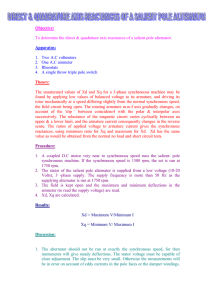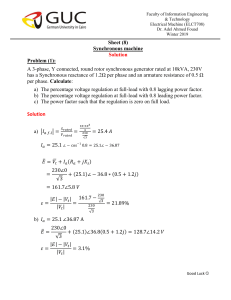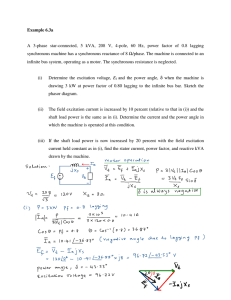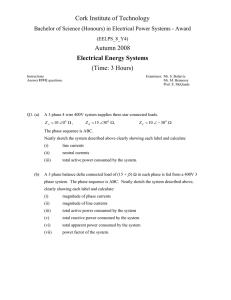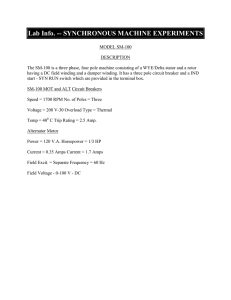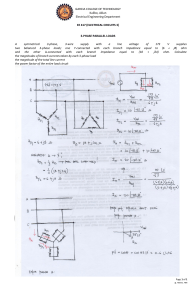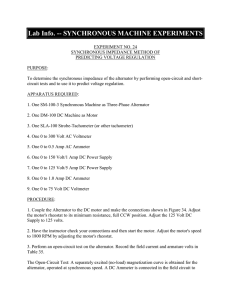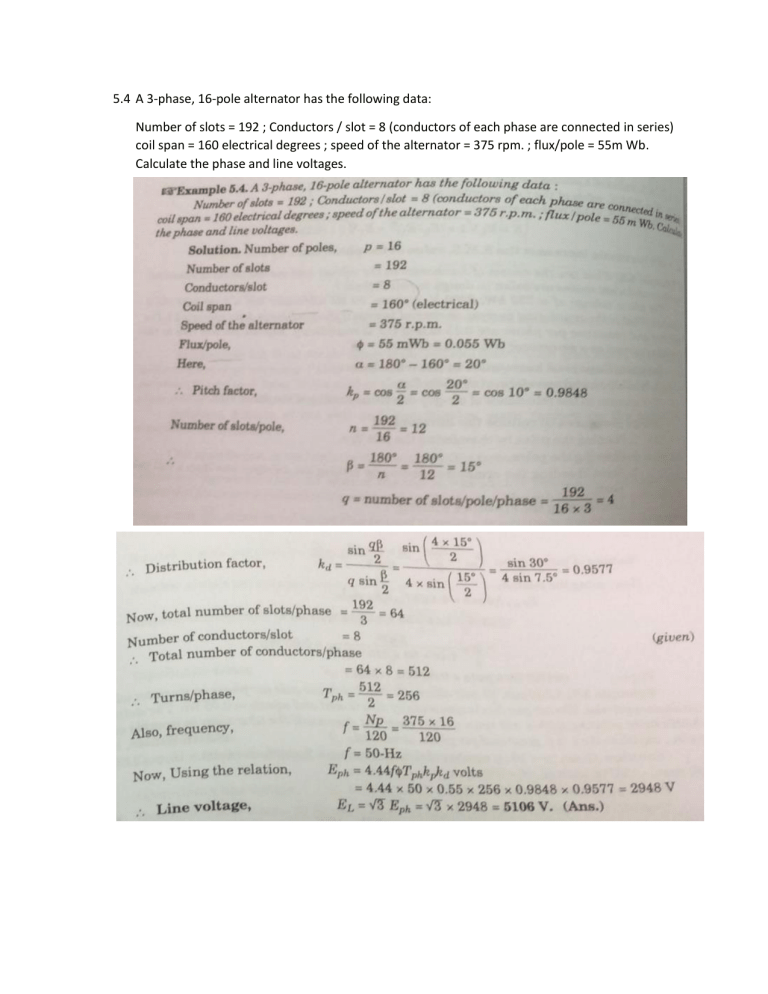
5.4 A 3-phase, 16-pole alternator has the following data: Number of slots = 192 ; Conductors / slot = 8 (conductors of each phase are connected in series) coil span = 160 electrical degrees ; speed of the alternator = 375 rpm. ; flux/pole = 55m Wb. Calculate the phase and line voltages. 5.5 A 3-phase, star-connected alternator has the following data: voltage required to be generated on open-circuit = 4000 V (at 50-Hz) ; speed = 500 rpm ; stator slots/pole/phase = 3 ; conductors/slot = 12. 5.6 A 3-phase, 10-pole alternator has 2 slots per pole per phase on its stator with conductors per slot. The air gap flux is sinusoidally distributed and equals to 0.05 Wb. The stator double layer winding with a coil span of 150° electrical degrees. If the alternator is running of rpm. Calculate the emf generated per phase at no load. 5.7 Calculate the speed and open-circuit line and phase voltages of a 4-pole, 3phase, 50 Hz starconnected alternator with 36 slots and 30 conductors per slot. The flux per pole is 0.05 Wb sinusoidally distributed. 5.8 A 4-pole, 50 Hz star-connected alternator has a flux per pole of 0.12 Wb. It has 4 slots per pole per phase, conductors per slot being 4. If the winding coil span is 150°, find the emf. 5.9 A 3-phase, 4-pole, 50 Hz star-connected alternator has 60 slots with 2 conductors per slot and having armature winding of the double layer type. Coils are short-pitched, that is, if one coil slide lies in slot number 1, the other coil side lies in slot number 13. Find the useful flux per pole required to induce a line voltage of 6.6 kV 5.10 An 8-pole, 3-phase, 60° spread, double layer winding has 72 coils in 72 slots. The coils are short-pitched by two slots. Calculate the winding the factor for the fundamental and third Harmonic. 5.11 Calculate the rms value of the induced emf per phase of a 10-pole,3-𝜑, 50 Hz alternator with 2 slots per pole per phase and 4 conductors per slot in two layers. The coil span is 150°. The flux per pole has a fundamental component component of 0.12 Wb and a 20% third harmonic component. 5.15 A 600 V, 60 kVA, single-phase alternator has an effective resistance of 0.2 ohm. A field current of 10 A produces an armature current of 210 A on short-circuit and emf of 480 V on open-circuit. Calculate: (i) Synchronous impedance and reactance. (ii)Full-load regulation with 0.8 p.f. lagging 5.16 A 3-phase star-connected alternator is rated at 1500 kVA, 12000 V. The armature effective resistance and synchronous reactance are 2 ohm and 35 ohm respectively per phase. Calculate the percentage regulation for a load of 1200 kW at power factors of: (i) 0.8 lagging (ii) 0.8 leading 5.17 A 3300 V, 3-phase star-connected alternator has a full load current of 100 A. On short-circuit a field current of 5 amperes was necessary to produce full-load current. The emf on open-circuit for the same excitation was 900 volts. The armature resistance was 0.8 ohm/phase. Determine the full-load voltage regulation for: (i) 0.8 pf lagging (ii) 0.8 pf leading 5.18 A 3.3 kV, 3-phase star-connected alternator has a full-load current of 100 A. Under short-circuit condition it takes 5 A field current to produce full-load short-circuit current. The emf on open circuit for the same excitation is 900 V (line-to-line). The armature resistance is 0.9 ohm/phase. Determine synchronous reactance per phase and regulation for (i) 0.8 pf lagging (ii) 0.8 pg leading. 5.19 A 3-phase, star-connected, 1000 kVA, 11000 V alternator has rated current of 52.5 A. The A.C. resistance of the winding per phase is 0.45 ohm. The test results are given below: O.C. test: Field current = 12.5 A, voltage between lines = 422 V S.C. test: Field current = 12.5 A, line current = 52.5 A Determine the full-load voltage regulation of the alternator (a) 0.8 pf lagging and (b) 0.8 pf leading. 5.21 A 3-phase, 50 Hz, 6000 kVA, 6000 V star-connected alternator has an effective resistance of 0.2 ohm. A field current of 10 A produces 480 V on open circuit and a field current of 5 A gives armature current of 105 A. Calculate the voltage regulation of this alternator at 0.8 power for lagging. 5.21 (b) A 3-phase, Y-connected, 11 kV, 165 MVA alternator has a synchronous reactance of 1 ohm and armature resistance of 0.1 ohm per phase. Calculate short circuit current at the instant of short current and sustained short circuit current. (c) The data obtained on 100 kVA, 1100 V, 3-phase alternator in d.c. resistance test, E between lines = 6 V d.c., I in lines = 10 A d.c., Open circuit test, field current = 12 A d.c., Line voltage = 420 V a.c. , short circuit test, field current = 12.5 A d.c., Line current = rated value. Calculate the voltage regulation of alternator at 0.8 p.f. lagging. 5.22 A 1500 kVA, 6600-V, 3ohase star-connected alternator with a resistance of 0.4 ohm and reactance of 6 ohms per phase, delivers full-load current at power factor 0.8 lagging and normal rated voltage. Estimate the terminal voltage for the same excitation and load current 0.8 power factor leading. 5.24 A 3-phase star-connected synchronous generator is rated at 1.5 MVA, 11kV. The armature effective resistance and synchronous reactance are 1.2 ohm and 15 ohm respectively per phase. Calculate the percentage regulation for a load of 1.4375 MVA at (i) 0.8 pf lagging and (ii) 0.8 pf leading. Also find the power factor at which the regulations becomes zero. 5.27 A 6600 V alternator gave the following test results: O.C voltage, V: 3100 4900 6600 7500 8300 Field Current, A: 16 25 37.5 50 70 A field current of 22 A is found necessary to circulate full-load current on short-circuit of the armature. Calculate the full-load regulation at 0.8 power factor lagging by: (i) (ii) The ampere-turn method. The synchronous impedance method 5.28 The following O.C.C was obtained in case of a 3-phaes, 6000 V … running at normal speed. Field current, A: 14 18 Terminal voltage, V: 4000 23 30 43 5000 6000 7000 8000 The field current is 17 A when armature is short-circuited and the full-load current is …. Using synchronous method, determine the voltage regulation of the alternator supply the full-load of 200 kVA at 0.707 lagging. Neglect armature resistance. 5.33 A 10 kVA, 440 V, 50 Hz, 3-phase alternator has the open-circuit characteristic below Field current, A: 1.5 3.0 Terminal voltage, V: 150 5.0 300 440 8.0 11.0 15.0 550 600 635 With full-load zero power factor applied an excitation of 14 A produced a terminal voltage 500 V on short-circuit, 4 A excitation was required to give full-load current. Determine as accurately as possible, the percentage regulation for full-load 0.8 pf. (i) lagging (ii) leading. 5.35 A 2200 V, 50 Hz, 3-phas, star-connected alternator has an effective resistance of 0.5 ohm per phase. A field current of 30 A produced the full-load current of 200 A on short-circuit and a line-to-line emf of 1100 V on open-circuit. Determine: (i) The power angle of the alternator when it delivers full-load at 0.8 pf (lag). (ii) The SCR of the alternator. 5.36 A 3-phase synchronous generator has per phase a direct axis synchronous reactance of 1.0 per unit and quadrature axis synchronous reactance of 0.65 per unit. Determine the diagram of the machine when operating at full-load at a power factor of 0.8 lagging and find there: (i) the load angle (ii) per unit no-load emf. Neglect armature resistance. 5.37 A 5 kVA, 220 V, star-connected 3-phse salient pole alternator with direct … quadrature axes reactances of 12 ohm and 7 ohm respectively, delivers full-load current at unity power factor. Calculate the excitation voltage, neglecting resistance. 5.38 A 10 kVA, 380 v, 50 Hz , 3-phase, star-connected salient pole alternator has direct axis and quadrature axis and quadrature axis reactances of 12 ohm and 8 ohm respectively. The armature has a resistance of 1 ohm per phase. The generator delivers rated load at 0.8 power factor lagging with the terminal voltage being maintained at rated value. If the load angle is 16.15 degree, determine: (i) the direct axis and quadrature axis components of armature current (ii) excitation voltage of the generator 5.39 A 3-phase star-connected alternator is delivering 20 MW and 8 MVA to an infinite bus at 11 kV. The alternator has synchronous impedance of 0+j3 ohm. Determine the load angle and the excitation emf of the alternator. 5.40 A 3.5 MVA, slow speed, 3-phase synchronous generator rated at 6.6 kV has 32 poles. Its direct and quadrature axes synchronous reactances as measured by the slip test are 0.6 ohm and 6 ohms respectively. (i) Neglecting armature resistance, determine the regulation and excitation emf needed to maintain 6.6 kV at the terminals when supplying a load of 2.5 MW at 0.8 power factor lagging. (ii) What maximum power can generator supply at the rated terminal voltage if the … becomes opencircuited? 5.41 A 3-phase, 17.32 kVA, 400 V, star-connected alternator is delivering rated load at 400 V and at pf 0.8 lag. Its synchronous impedance is 0.2 + j2 ohm per phase. Find the load angle at which it is operating. 5.42 A 10000 kVA, 3-phase, star-connected 11000 V, 2-pole turbo-generator has a synchronous impedance of (0.0145 + j0.5) ohms per phase. The various losses in this generator are as follows: Open-circuits core loss at 11000 V = 90kW ; Windage and friction loss = 50 kW ; Short-circuit load loss at 525 A = 220 kW; Field winding resistance = 3 ohm; Field current = 175 A. Ignoring the change in field current, compute the efficiency at : (i) (ii) Rated load, 0.8 power factor leading; Half rated load, 0.9 power factor lagging. 5.43 A 2 MVA, 3.3 kV, 3-phase, star-connected alternator delivers rated load at a 0.8 lagging. The effective resistance between armature winding terminals is 0.12 ohm. The field takes 70 A at 130 V. Friction and windage loss is 15 kW and the core losses are 32 kW. Determine the full-load efficiency of the alternator. 5.45 A 4 MVA , 10 kV, 1500 rpm, 50 Hz alternator runs in parallel with other machines. Its synchronous reactance is 25%. Find for (i) no-load (ii) full-load at pf 0.9 lagging synchronizing power per unit mechanical angle of phase displacement, and calculate its synchronizing torque if the mechanical displacement is 0.7. 5.46 A 4500 kVA, 50 Hz, 3-phase synchronous generator having a synchronous reactance of 0.3 p.u. is running at 1500 rpm and is excited to give 11000V. If the rotor decreases slightly from its equilibrium position, what is the synchronizing torque in N-m degree mechanical displacement. 5.47 A 2-pole, 50 Hz, 3-phase, turbo alternator is excited to generate the bus-bar voltage of 11 kV on noload. The machine is star-connected and the short-circuit current for this excitation is 1000 A. Calculate the synchronizing power per degree of mechanical displacement of the rotor and the corresponding synchronizing torque. 5.48 3 MVA, 6-pole alternator runs at 1000 rpm on 3.3 kV bus-bars. The synchronous reactance is 25%. Calculate the synchronizing power and torque per mechanical degree of displacement when alternator is supplying full-load at 0.8 power factor lagging. 5.49 A number of alternators are working in parallel with their terminal voltage equal to the rated value. One of the machines, which has a synchronous reactance of 50% and a resistance of 1% delivers a power output in kW equal to 70% of its rated kVA. If the emf of this is… equals 1.2 times the terminal voltage, find out the power factor at which the machine is operating. 5.50 Two 1-phase alternators operate in parallel and supply a load impedance of (3+j4) ohm. If the impedance of each machine is (0.2+j2) and emfs are (200+j0) and (220+j0) volts respectively, determine for each machine: (i) terminal voltage (ii) power factor and (iii) output. 5.51 Two alternators working in parallel supply a lighting load of 3000 kW and a motor load aggregating to 5000 kW at a pf of 0.72. One machine is loaded up to 5000 kW at 0.8 pf lagging. What is the load and power factor of the other machine? 5.52 The following loads are supplied by two alternators running in parallel. (i) 1400 kW at pf 0.86 lagging (ii) 900 kW at pf 0.8 lagging (iii) 800 kW at pf unity (iv) 500 kW at pf 0.8 leading. If the load on one machine is adjusted to 2100 kW at pf 0.92, find the load and pf of the other machine. 5.64 A 12 MVA, 5000 V, 3-phase, 4-pole, 50 Hz alternator is connected to infinite bus-bars. The shortcircuit current is 4.0 time the normal full-load current and the moment of inertia of the rotating system is 22000 kg m^2. Determine the normal period of oscillation. 5.65 The following figures pertain ot a 2-pole, 50 Hz, 3-phase turbo-alternator connected to infinite bus. Rating = 120 MVA, supply voltage (line) = 33000 V, synchronous reactance of 0.6 pu, moment of inertia = 1.2 x 10^6 kg m^2. Calculate its natural frequency of oscillation. 5.66 A 10,000 kVA, 4-pole, 6600 V, 50 Hz, 3-phase star connected alternator has a synchronous reactance of 25% and operates on constant voltage, constant frequency bus-bars. If the natural period of oscillation while operating at full-load and unity power factor is to be limited to 1.5 seconds, calculate the moment of inertia of the rotating system. 5.67 A 100 MVA synchronous generator operates on full-load at frequency of 50 Hz. The load is suddenly reduced to 50 MW. Due to time lag in governor system the steam valve begins to close after 0.4 second. Determine the change in frequency that occurs in this time Given H = 5 kW-s/ kVA of generating capacity. 5.68 A 3-phase, 11 kV, 5 MVA, star-connected alternator has a synchronous impedance of (1+j12) ohm per phase. Its excitation is such that the generated line emf is 12 kV. If the alternator is connected to infinite bus bars, determine the maximum output at the given excitation. 5.69 A 3-phase, 11 kV, 10 MW, star-connected synchronous generator has a synchronous impedance of (0.6+j10) ohm per phase. If the excitation is such that the open-circuit voltage is 12 kV. Determine: (i) maximum output of the generator (ii) current and pf at maximum output. 37.5. An alternator has 18 slots/pole and the first coil lies in slots 1 and 16. Calculate the pitch factor for (i) fundamental (ii) 3rd harmonic (iii) 5th harmonic and (iv) 7th harmonic. 37.6. A 3-phase, 16-pole alternator has a star-connected winding with 144 slots and 10 conductors per slot. The flux per pole is 0.03 Wb, Sinusoidally distributed and the speed is 375 r.p.m. Find the frequency rpm and the phase and line e.m.f. Assume full-pitched coil. 37.7. Find the no-load phase and line voltage of a star-connected 3-phase, 6-pole alternator which runs at 1200 rpm, having flux per pole of 0.1 Wb sinusoidally distributed. Its stator has 54 slots having double layer winding. Each coil has 8 turns and the coil is chorded by 1 slot. 37.8 The stator of a 3-phase, 16-pole alternator has 144 slots and there are 4 conductors per slot connected in two layers and the conductors of each phase are connected in series. If the speed of the alternator is 375 r.p.m., calculate the e.m.f. inducted per phase. Resultant flux in the air-gap is 5 × 10− 2 webers per pole sinusoidally distributed. Assume the coil span as 150° electrical. 37.10. A 4-pole, 3-phase, 50-Hz, star-connected alternator has 60 slots, with 4 conductors per slot. Coils are short-pitched by 3 slots. If the phase spread is 60º, find the line voltage induced for a flux per pole of 0.943 Wb distributed sinusoidally in space. All the turns per phase are in series. 37.11. A 4-pole, 50-Hz, star-connected alternator has 15 slots per pole and each slot has 10 conductors. All the conductors of each phase are connected in series' the winding factor being 0.95. When running on no-load for a certain flux per pole, the terminal e.m.f. was 1825 volt. If the windings are lap-connected as in a d.c. machine, what would be the e.m.f. between the brushes for the same speed and the same flux/pole. Assume sinusoidal distribution of flux. 37.12. An alternator on open-circuit generates 360 V at 60 Hz when the field current is 3.6 A. Neglecting saturation, determine the open-circuit e.m.f. when the frequency is 40 Hz and the field current is 2.4 A. 37.13. Calculate the R.M.S. value of the induced e.m.f. per phase of a 10-pole, 3-phase, 50-Hz alternator with 2 slots per pole per phase and 4 conductors per slot in two layers. The coil span is 150°. The flux per pole has a fundamental component of 0.12 Wb and a 20% third component. 37.14. A 3-phase alternator has generated e.m.f. per phase of 230 V with 10 per cent third harmonic and 6 per cent fifth harmonic content. Calculate the r.m.s. line voltage for (a) star connection (b) delta-connection. Find also the circulating current in delta connection if the reactance per phase of the machine at 50-Hz is 10 Ω. 37.15 (a). A motor generator set used for providing variable frequency a.c. supply consists of a three-phase, 10-pole synchronous motor and a 24-pole, three- phase synchronous generator. The motor-generator set is fed from a 25 Hz, three-phase a.c. supply. A 6-pole, threephase induction motor is electrically connected to the terminals of the synchronous generator and runs at a slip of 5%. Determine : (i) the frequency of the generated voltage of the synchronous generator. (ii) the speed at which the induction motor is running. 37.15 (b). Find the no load line voltage of a star connected 4-pole alternator from the following : Flux per pole = 0.12 Weber, Slots per pole per phase = 4 Conductors/ slot = 4, Two layer winding, with coil span = 150° 37.16. A 3-phase, star-connected alternator supplies a load of 10 MW at p.f. 0.85 lagging and at 11 kV (terminal voltage). Its resistance is 0.1 ohm per phase and synchronous reactance 0.66 ohm per phase. Calculate the line value of e.m.f. generated. 37.17 (a). The effective resistance of a 2200V, 50Hz, 440 KVA, 1-phase, alternator is 0.5 ohm. On short circuit, a field current of 40 A gives the full load current of 200 A. The electromotive force on open-circuits with same field excitation is 1160 V. Calculate the synchronous impedance and reactance. 37.17 (b). A 60-KVA, 220 V, 50-Hz, 1- φ alternator has effective armature resistance of 0.016 ohm and an armature leakage reactance of 0.07 ohm. Compute the voltage induced in the armature when the alternator is delivering rated current at a load power factor of (a) unity (b) 0.7 lagging and (c) 0.7 leading. 37.18 (a). In a 50-kVA, star-connected, 440-V, 3-phase, 50-Hz alternator, the effective armature resistance is 0.25 ohm per phase. The synchronous reactance is 3.2 ohm per phase and leakage reactance is 0.5 ohm per phase. Determine at rated load and unity power factor: (a) Internal e.m.f. Ea (b) no-load e.m.f. E0 (c) percentage regulation on full-load (d) value of synchronous reactance which replaces armature reaction. 37.18 (b). A 1000 kVA, 3300-V, 3-phase, star-connected alternator delivers full-load current at rated voltage at 0.80 p. f. Lagging. The resistance and synchronous reactance of the machine per phase are 0.5 ohm and 5 ohms respectively. Estimate the terminal voltage for the same excitation and same load current at 0.80 p. f. leading. 37.19. Find the synchronous impedance and reactance of an alternator in which a given field current produces an armature current of 200 A on short-circuit and a generated e.m.f. of 50 V on open-circuit. The armature resistance is 0.1 ohm. To what induced voltage must the alternator be excited if it is to deliver a load of 100 A at a p.f. of 0.8 lagging, with a terminal voltage of 200V. 37.20. From the following test results, determine the voltage regulation of a 2000-V, 1-phase alternator delivering a current of 100 A at (i) unity p.f. (ii) 0.8 leading p.f. and (iii) 0.71 lagging p.f. Test results : Full-load current of 100 A is produced on short-circuit by a field excitation of 2.5A. An e.m.f. of 500 V is produced on open-circuit by the same excitation. The armature resistance is 0.8Ω. 37.21. A 100-kVA, 3000-V, 50-Hz 3-phase star-connected alternator has effective armature resistance of 0.2 ohm. The field current of 40 A produces short-circuit current of 200 A and an open-circuit emf of 1040 V (line value). Calculate the full-load voltage regulation at 0.8 p.f. lagging and 0.8 p.f. leading. Draw phasor diagrams. 37.22. A 3-phase, star-connected alternator is rated at 1600 kVA, 13,500 V. The armature resistance and synchronous reactance are 1.5 Ω and 30 Ω respectively per phase. Calculate the percentage regulation for a load of 1280 kW at 0.8 leading power factor. 37.23. A 3-phase, 10-kVA, 400-V, 50-Hz, Y-connected alternator supplies the rated load at 0.8 p.f. lag. If arm. resistance is 0.5 ohm and syn. reactance is 10 ohms, find the power angle and voltage regulation. 37.24. The following test results are obtained from a 3-phase, 6,000-kVA, 6,600 V, star-connected, 2pole, 50-Hz turbo-alternator: With a field current of 125 A, the open-circuit voltage is 8,000 V at the rated speed; with the same field current and rated speed, the short-circuit current is 800 A. At the rated full-load, the resistance drop is 3 per cent. Find the regulation of the alternator on full-load and at a power factor of 0.8 lagging. 37.25. A 3-phase 50-Hz star-connected 2000-kVA, 2300 V alternator gives a shortcircuit current of 600 A for a certain field excitation. With the same excitation, the open circuit voltage was 900 V. The resistance between a pair of terminals was 0.12 Ω. Find full-load regulation at (i) UPF (ii) 0.8 p.f. lagging. 37.26. A 2000-kVA, 11-kV, 3-phase, star-connected alternator has a resistance of 0.3 ohm and reactance of 5 ohm per phase. It delivers full-load current at 0.8 lagging power factor at rated voltage. Compute the terminal voltage for the same excitation and load current at 0.8 power factor leading. 37.27. The effective resistance of a 1200-kVA, 3.3-kV, 50-Hz, 3-phase, Y-connected alternator is 0.25 Ω/phase. A field current of 35 A produces a current of 200 A on short-circuit and 1.1 kV (line to line) on open circuit. Calculate the power angle and p.u. change in magnitude of the terminal voltage when the full load of 1200 kVA at 0.8 p.f. (lag) is thrown off. Draw the corresponding phasor diagram. 37.28. A given 3-MVA, 50-Hz, 11-kV, 3-φ, Y-connected alternator when supplying 100 A at zero p.f. leading has a line-to-line voltage of 12,370 V; when the load is removed, the terminal voltage falls down to 11,000 V. Predict the regulation of the alternator when supplying full-load at 0.8 p.f. lag. Assume an effective resistance of 0.4 Ω per phase. 37.29. A straight line law connects terminal voltage and load of a 3-phase star-connected alternator delivering current at 0.8 power factor lagging. At no-load, the terminal voltage is 3,500 V and at full-load of 2,280 kW, it is 3,300 V. Calculate the terminal voltage when delivering current to a 3-φ, starconnected load having a resistance of 8 Ω and a reactance of 6 Ω per phase. Assume constant speed and field excitation. 37.30. A 3.5-MVA, Y-connected alternator rated at 4160 volts at 50-Hz has the opencircuit characteristic given by the following data : Field Current (Amps) 50 100 150 200 250 300 350 400 450 E.M.F. (Volts) 1620 3150 4160 4750 5130 5370 5550 5650 5750 A field current of 200 A is found necessary to circulate full-load current on short-circuit of the alternator. Calculate by (i) synchronous impedance method and (ii) ampere-turn method the fullload voltage regulation at 0.8 p.f. lagging. Neglect resistance. Comment on the results obtained 37.31. The following test results are obtained on a 6,600-V alternator: Open-circuit voltage : 3,100 4,900 6,600 7,500 8,300 Field current (amps) : 16 25 37.5 50 70 A field current of 20 A is found necessary to circulate full-load current on short-circuit of the armature. Calculate by (i) the ampere-turn method and (ii) the synchronous impedance method the full-load regulation at 0.8 p.f. (lag). Neglect resistance and leakage reactance. State the drawbacks of each of these methods. 37.32. The open-and short-circuit test readings for a 3- φ , star-connected, 1000-kVA, 2000 V, 50-Hz, synchronous generator are : Field Amps ; 10 20 25 30 40 50 O.C. Terminal V: 800 1500 1760 2000 2350 2600 S.C. armature current in A: — 200 250 300 — — The armature effective resistance is 0.2 Ω per phase. Draw the characteristic curves and estimate the full-load percentage regulation at (a) 0.8 p.f. lagging (b) 0.8 p.f. leading. 37.33. A 3-phase, 800-kV A, 3,300-V, 50-Hz alternator gave the following results: Exciting current (A): 50 60 70 80 90 100 O.C. volt (line): 2560 3000 3300 3600 3800 3960 S.C. current: 190 — — — — — The armature leakage reactance drop is 10% and the resistance drop is 2% of the normal voltage. Determine the excitation at full-load 0.8 power factor lagging by the m.m.f. method. 37.34. A 3-phase, 6,00-V alternator has the following O.C.C. at normal speed : Field amperes : 14 18 23 30 43 Terminal volts : 4000 5000 6000 7000 8000 With armature short-circuited and full-load current flowing the field current is 17 A and when the machine is supplying full-load of 2,000 kVA at zero power factor, the field current is 42.5 A and the terminal voltage is 6,000 V. Determine the field current required when the machine is supplying the full-load at 0.8 p.f. lagging. 37.39. A 3-phase alternator has a direct-axis synchronous reactance of 0.7 p.u. and a quadrature axis synchronous reactance of 0.4 p.u. Draw the vector diagram for full-load 0.8 p.f. lagging and obtain therefrom (i) the load angle and (ii) the no-load per unit voltage. 37.40. A 3-phase, star-connected, 50-Hz synchronous generator has direct-axis synchronous reactance of 0.6 p.u. and quadrature-axis synchronous reactance of 0.45 p.u. The generator delivers rated kVA at rated voltage. Draw the phasor diagram at full-load 0.8 p.f. lagging and hence calculate the open-circuit voltage and voltage regulation. Resistive drop at full-load is 0.015 p.u. 37.41. A 3-phase, Y-connected syn. generator supplies current of 10 A having phase angle of 20° lagging at 400 V. Find the load angle and the components of armature current I d and I q if X d = 10 ohm and X q = 6.5 ohm. Assume arm. resistance to be negligible. 37.43. Find the power angle when a 1500-kVA, 6.6 kV, 3-phase, Y-connected alternator having a resistance of 0.4 ohm and a reactance of 6 ohm per phase delivers full-load current at normal rated voltage and 0.8 p.f. lag. Draw the phasor diagram. 37.44. A 3,000-kVA, 6-pole alternator runs at 1000 r.p.m. in parallel with other machines on 3,300-V busbars. The synchronous reactance is 25%. Calculate the synchronizing power for one mechanical degree of displacement and the corresponding synchronizing torque. 37.45. A 3-MVA, 6-pole alternator runs at 1000 r.p.m on 3.3-kV bus-bars. The synchronous reactance is 25 percent. Calculate the synchronising power and torque per mechanical degree of displacement when the alternator is supplying full-load at 0.8 lag. 37.46. A 750-kVA, 11-kV, 4-pole, 3-φ, star-connected alternator has percentage resistance and reactance of 1 and 15 respectively. Calculate the synchronising power per mechanical degree of displacement at (a) no-load (b) at full-load 0.8 p.f. lag. The terminal voltage in each case is 11 kV. 37.47. A 2,000-kVA, 3-phase, 8-pole alternator runs at 750 r.p.m. in parallel with other machines on 6,000 V bus-bars. Find synchronizing power on full-load 0.8 p.f. lagging per mechanical degree of displacement and the corresponding synchronizing torque. The synchronous reactance is 6 ohm per phase. 37.48. A 5,000-kV A, 10,000 V, 1500-r.p.m., 50-Hz alternator runs in parallel with other machines. Its synchronous reactance is 20%. Find for (a) no-load (b) full-load at power factor 0.8 lagging, synchronizing power per unit mechanical angle of phase displacement and calculate the synchronizing torque, if the mechanical displacement is 0.5°. 37.49. Two 3-phase, 6.6-kW, star-connected alternators supply a load of 3000 kW at 0.8 p.f. lagging. The synchronous impedance per phase of machine A is (0.5 + j10) Ω and of machine B is (0.4 + j 12) Ω. The excitation of machine A is adjusted so that it delivers 150 A at a lagging power factor and the governors are so set that load is shared equally between the machines. Determine the current, power factor, induced e.m.f. and load angle of each machine. 37.50. Two single-phase alternator operating in parallel have induced e.m.fs on open circuit of 230 ∠ 0° and 230 ∠ 10° volts and respective reactances of j2 Ω and j3 Ω. Calculate (i) terminal voltage (ii) currents and (iii) power delivered by each of the alternators to a load of impedance 6 Ω (resistive). 37.51. Two identical 3-phase alternators work in parallel and supply a total load of 1, 500 kW at 11 kV at a power factor of 0.867 lagging. Each machine supplies half the total power. The synchronous reactance of each is 50 Ω per phase and the resistance is 4 Ω per phase. The field excitation of the first machine is so adjusted that its armature current is 50 A lagging. Determine the armature current of the second alternator and the generated voltage of the first machine. 37.52. Two alternators A and B operate in parallel and supply a load of 10 MW at 0.8 p.f. lagging (a) By adjusting steam supply of A, its power output is adjusted to 6,000 kW and by changing its excitation, its p.f. is adjusted to 0.92 lag. Find the p.f. of alternator B. (b) If steam supply of both machines is left unchanged, but excitation of B is reduced so that its p.f. becomes 0.92 lead, find new p.f. of A. 37.59 Two 3-φ synchronous mechanically-coupled generators operate in parallel on the same load. Determine the kW output and p.f. of each machine under the following conditions: synchronous impedance of each generator : 0.2 + j2 ohm/phase. Equivalent impedance of the load: 3 + j4 ohm/phase. Induced e.m.f. per phase, 2000 + j0 volt for machine I and 2,2000 + j 100 for II 37.56. Two 20-MVA, 3-φ alternators operate in parallel to supply a load of 35MVA at 0.8 p.f. lagging. If the output of one machine is 25 MVA at 0.9 lagging, what is the output and p.f. of the other machine? 37.58. Two alternators, working in parallel, supply the following loads : (i) Lighting load of 500 kW (ii) 1000 kW at p.f. 0.9 lagging (iii) 800 kW at p.f. 0.8 lagging (iv) 500 kW at p.f. 0.9 leading One alternator is supplying 1500 kW at 0.95 p.f. lagging. Calculate the kW output and p.f of the other machine 37.63. A 5,000-kVA, 3-phase, 10,000-V, 50-Hz alternate runs at 1500 r.p.m. connected to constantfrequency, constant-voltage bus-bars. If the moment of inertia of entire rotating system is 1.5 × 104 kg.m2 and the steady short-circuit current is 5 times the normal full-load current, find the natural time period of oscillation. 37.64. A 10,000-kVA, 4-pole, 6,600-V, 50-Hz, 3-phase star-connected alternator has a synchronous reactance of 25% and operates on constant-voltage, constant frequency bus-bars. If the natural period of oscillation while operating at full-load and unity power factor is to be limited to 1.5 second, calculate the moment of inertia of the rotating system. 37.65. A 10-MVA, 10-kV, 3-phase, 50-Hz, 1500 r.p.m. alternator is paralleled with others of much greater capacity. The moment of inertia of the rotor is 2 × 105 kg-m2 and the synchronous reactance of the machine is 40%. Calculate the frequency of oscillation of the rotor. 37.66. Derive the condition for the maximum output of a synchronous generator connected to infinite bus-bars and working at constant excitation. A 3- φ , 11-kV, 5-MVA, Y-connected alternator has a synchronous impedance of (1 + j 10) ohm per phase. Its excitation is such that the generated line e.m.f. is 14 kV. If the alternator is connected to infinite bus-bars, determine the maximum output at the given excitation 37.67. A 3-phase, 11-kVA, 10-MW, Y-connected synchronous generator has synchronous impedance of (0.8 + j 8.0) ohm per phase. If the excitation is such that the open circuit voltage is 14 kV, determine (i) the maximum output of the generator (ii) the current and p.f. at the maximum output. 1. A 3-phase, wye-connected alternator is rated at 2,000 kVA, 13.5 kV. The effective resistance and synchronous reactance of the armature are 1.3 ohm and 20 ohms, respectively. What is the regulation for a power factor of 0.80 lagging? 2. A 1,500 kVA, 6.6 kV, 3-phase, wye-connected alternator has an effective resistance of 0.5 ohm per phase and a synchronous reactance of 5 ohms per phase. What is the percentage rise in voltage when rated gull output at 0.80 lagging power factor at rated voltage is suddenly switched off? 4. A 3-phase, wye connected alternator rated at 1,600 kVA, 13.5 kV. The effective armature resistance and synchronous reactance are 1.5 ohms and 30 ohms, respectively. What is the percent regulation for a load of 1,280 kW at 0.80 leading power factor? 8. A 1,500 kVA, 3-phase alternator is connected to an infinite busbar at constant voltage of 11,000 volts. The resistance and reactance per phase are 0.10 ohm and 2.4 ohms respectively. Find (a) the maximum external load that the machine can supply when the machine is excited to give an emf of 12,500 volts, (b) the current and pf at the maximum output. 10. Two identical 20MW alternators operate in parallel. The governor of first machine is such that the frequency drops uniformly form 50 Hz on no-load to 48 Hz on full-load. The corresponding uniform speed drop of the second machine is from 50 Hz to 47.5 Hz. How will the two machines share a load of 30 MW? 11. A 10,000-kVA, 4-pole, 6,600-V, 50-Hz, 3-phase star-connected alternator has a synchronous reactance of 25% and operates on constant voltage, constant frequency bus-bars. If the natural period of oscillation while operating at full-loaf and unity power factor is to be limited to 1.5 second, calculate the moment of inertia of the rotating system. 1. A 4-pole, 3 phase, 60 Hz, wye-connected, alternator having 60 slots with 2 conductors per slot in 2 layers. Fractional pitch winding with one side in slot no. 1 and the other side in slot no. 13. Determine the flux per pole required to induced an emf of 6,600 volts between lines. 2. A 1,000 kVA, 3,000 volts, 60 Hz, 3-phase, Y-connected alternator has an armature effective resistance of 0.20 ohm. A field current of 40 A, produces a short circuit current of 200 A and an open circuit emf of 1,040 between lines. Determine the full-load percent regulation at 0.80 lagging power factor. 3. A 3-phase, 50 Hz, star-connected, 1000 kVA, 2,300 V alternator gives a short circuit current of 400 A for a certain field excitation. With the same field excitation, the open circuit voltage was 1,328 V per phase. The dc resistance between two lies is 0.412 ohms. Find the full-load voltage regulation at 0.8 pf lagging .Assume effective armature resistance is 1.5 times the dc resistance due to skin effect. 4. A 20,000 kVA, 11,000 V, 3-phase, star connected alternator running on constant voltage, constant frequency bus-bars has a resistance of 0.05 ohm/phase and a synchronous reactance of 1.8 ohms/phase. If excited to give a terminal voltage of 13,000 V on open-circuit, find its maximum possible output power. 5. A 5.5 MVA, 50 Hz, 3-phase synchronous generator having a synchronous reactance of 30% is running at 1500 rpm and is excited to give 11 kV. If the rotor deviates slightly from its equilibrium position, what is the corresponding torque in N-m per degree mechanical displacement? 6. A 3-phase star-connected synchronous generator supplies current of 10 A having phase angle of 20 degrees lagging at 400 V per phase. Find (a) the load angle (b) components of Id and Iq of armature current (c) voltage regulation. Given: Xd = 10 ohms and Xq = 6.5 ohms. Neglect armature resistance. 7. A 9 kVA, 208 V, 1200 rpm, 3-phase, 60 Hz, star-connected generator has a field winding resistance of 4.5 ohms. The armature winding impedance is (0.3+j5) ohms per phase. When the generator operates at its full-load and 0.8 pf lagging, the field winding current is 5 A. The rotational loss is 500 W. Determine the (a) voltage regulation and (b) efficiency of alternator.
